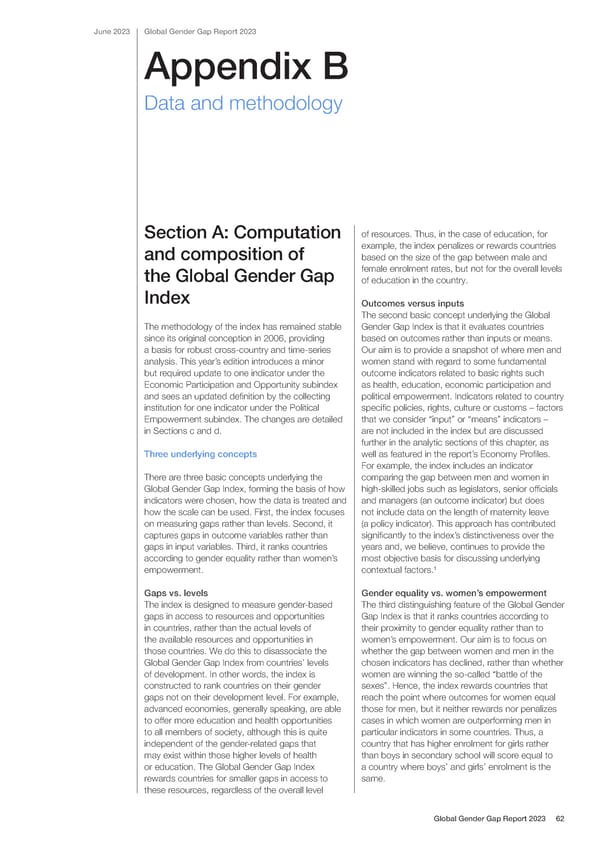June 2023 Global Gender Gap Report 2023 Appendix B Data and methodology Section A: Computation of resources. Thus, in the case of education, for and composition of example, the index penalizes or rewards countries based on the size of the gap between male and the Global Gender Gap female enrolment rates, but not for the overall levels of education in the country. Index Outcomes versus inputs The second basic concept underlying the Global The methodology of the index has remained stable Gender Gap Index is that it evaluates countries since its original conception in 2006, providing based on outcomes rather than inputs or means. a basis for robust cross-country and time-series Our aim is to provide a snapshot of where men and analysis. This year’s edition introduces a minor women stand with regard to some fundamental but required update to one indicator under the outcome indicators related to basic rights such Economic Participation and Opportunity subindex as health, education, economic participation and and sees an updated de昀椀nition by the collecting political empowerment. Indicators related to country institution for one indicator under the Political speci昀椀c policies, rights, culture or customs – factors Empowerment subindex. The changes are detailed that we consider “input” or “means” indicators – in Sections c and d. are not included in the index but are discussed further in the analytic sections of this chapter, as Three underlying concepts well as featured in the report’s Economy Pro昀椀les. For example, the index includes an indicator There are three basic concepts underlying the comparing the gap between men and women in Global Gender Gap Index, forming the basis of how high-skilled jobs such as legislators, senior of昀椀cials indicators were chosen, how the data is treated and and managers (an outcome indicator) but does how the scale can be used. First, the index focuses not include data on the length of maternity leave on measuring gaps rather than levels. Second, it (a policy indicator). This approach has contributed captures gaps in outcome variables rather than signi昀椀cantly to the index’s distinctiveness over the gaps in input variables. Third, it ranks countries years and, we believe, continues to provide the according to gender equality rather than women’s most objective basis for discussing underlying empowerment. contextual factors.1 Gaps vs. levels Gender equality vs. women’s empowerment The index is designed to measure gender-based The third distinguishing feature of the Global Gender gaps in access to resources and opportunities Gap Index is that it ranks countries according to in countries, rather than the actual levels of their proximity to gender equality rather than to the available resources and opportunities in women’s empowerment. Our aim is to focus on those countries. We do this to disassociate the whether the gap between women and men in the Global Gender Gap Index from countries’ levels chosen indicators has declined, rather than whether of development. In other words, the index is women are winning the so-called “battle of the constructed to rank countries on their gender sexes”. Hence, the index rewards countries that gaps not on their development level. For example, reach the point where outcomes for women equal advanced economies, generally speaking, are able those for men, but it neither rewards nor penalizes to offer more education and health opportunities cases in which women are outperforming men in to all members of society, although this is quite particular indicators in some countries. Thus, a independent of the gender-related gaps that country that has higher enrolment for girls rather may exist within those higher levels of health than boys in secondary school will score equal to or education. The Global Gender Gap Index a country where boys’ and girls’ enrolment is the rewards countries for smaller gaps in access to same. these resources, regardless of the overall level Global Gender Gap Report 2023 62
 Global Gender Gap Report 2023 Page 61 Page 63
Global Gender Gap Report 2023 Page 61 Page 63